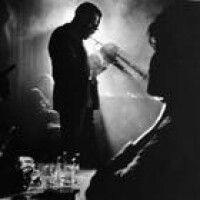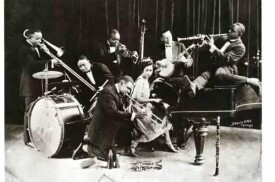冷爵士
冷爵士
冷爵士,出現於四十年代末,盛行於五十年代,與“熱爵士樂”相對應,也稱“涼爵士樂”,它在演奏上偏於輕鬆從容,是一種柔美的爵士樂風格。由於集徠中在美國西海岸,故又稱“西海岸爵士”(West Coast Jazz)。

冷爵士
從演奏形式上看,冷爵士有點類似於古典音樂中的室內樂,樂隊一般由3~6名樂手組成,其中最典型的是由鋼琴、貝司、鼓組成的爵士三重奏。薩克斯、小號、顫音琴等樂器也經常在冷爵士中作為主奏樂器出現。從音響上分辨,冷爵士總是給人一種鬆弛、悅耳的感覺,每種樂器互不干擾"點到為止"。冷爵士的另一特色體現在鼓的演奏技巧上,鼓手一般都用鋼絲製成的鼓刷進行演奏,對音色的控制極為細膩。因此,成千上萬的酒吧、咖啡廳里至今仍然以冷爵士作為背景音樂洗盡塵世的喧囂,為人們提供著清新自然的"柔美之音"。
邁爾斯.戴維斯(Miles Davis,1926~1991,作曲家,擅長樂器:小號)
戴夫.布魯貝克(Dave Brubeck,1920~2012,作曲家,擅長樂器:鋼琴)
切特.貝克(Chet Baker,1929~1988,擅長樂器:小號)
蓋瑞.穆里根(Gerry Mulligan,1927~1996,作曲家,編曲,擅長樂器:上低音薩克斯)
比爾.伊文斯(Bill Evans,1912~1988,作曲家,編曲,擅長樂器:鋼琴)
格徠魯夫音樂與音樂家中的詞條:
Cool jazz.
From the late 1940s, a jazz style derived largely from Bop, but advocating a moderation of those musical, emotional or ritualistic qualities associated with the parent style. Most of its musicians pursued a soft level of dynamics, for example favouring drum brushes rather than sticks, and many avoided a pronounced use of vibrato. Beyond this the pursuit of moderation was diverse and inconsistent. Possibilities included the meticulously restrained lyricism of Stan Getz’s solo on Early Autumn with Woody Herman’s Second Herd (1948, Cap.); the elimination of cutting sharply differentiated articulation, as heard in the highly chromatic and rather unmelodic unison themes and improvised lines presented by Lennie Tristano’s group (1949); an emphasis on mid-range register and subdued timbres, and a delicate balance between improvisation and composition, as practised by Miles Davis’s ‘Birth of the Cool’ nonet (1949–50); the Baroque- and Classically-influenced chamber jazz of the Modern Jazz Quartet (from 1952), with its concomitant appeal to an audience behaviour associated with the concert hall rather than the nightclub; the heady, transparent and contrapuntal dialogues improvised by Chet Baker and Gerry Mulligan in Mulligan’s pianoless quartet (also from 1952). Cool jazz led directly to another substyle of bop, West Coast jazz. The distinction between bop and cool jazz may seem obscure as these styles share many of the same conventions.
BIBLIOGRAPHY
M.Williams: ‘Bebop and After’, Jazz: New Perspectives on the History of Jazz, ed. N. Hentoff and A.J. McCarthy (New York, 1959/ R), 287–301
A.Hodeir: Toward Jazz (New York, 1962/ R)
H.Hellhund: Cool Jazz: Grundzüge seiner Entstehung und Entwicklung (Mainz, 1985)
BARRY KERNFELD
